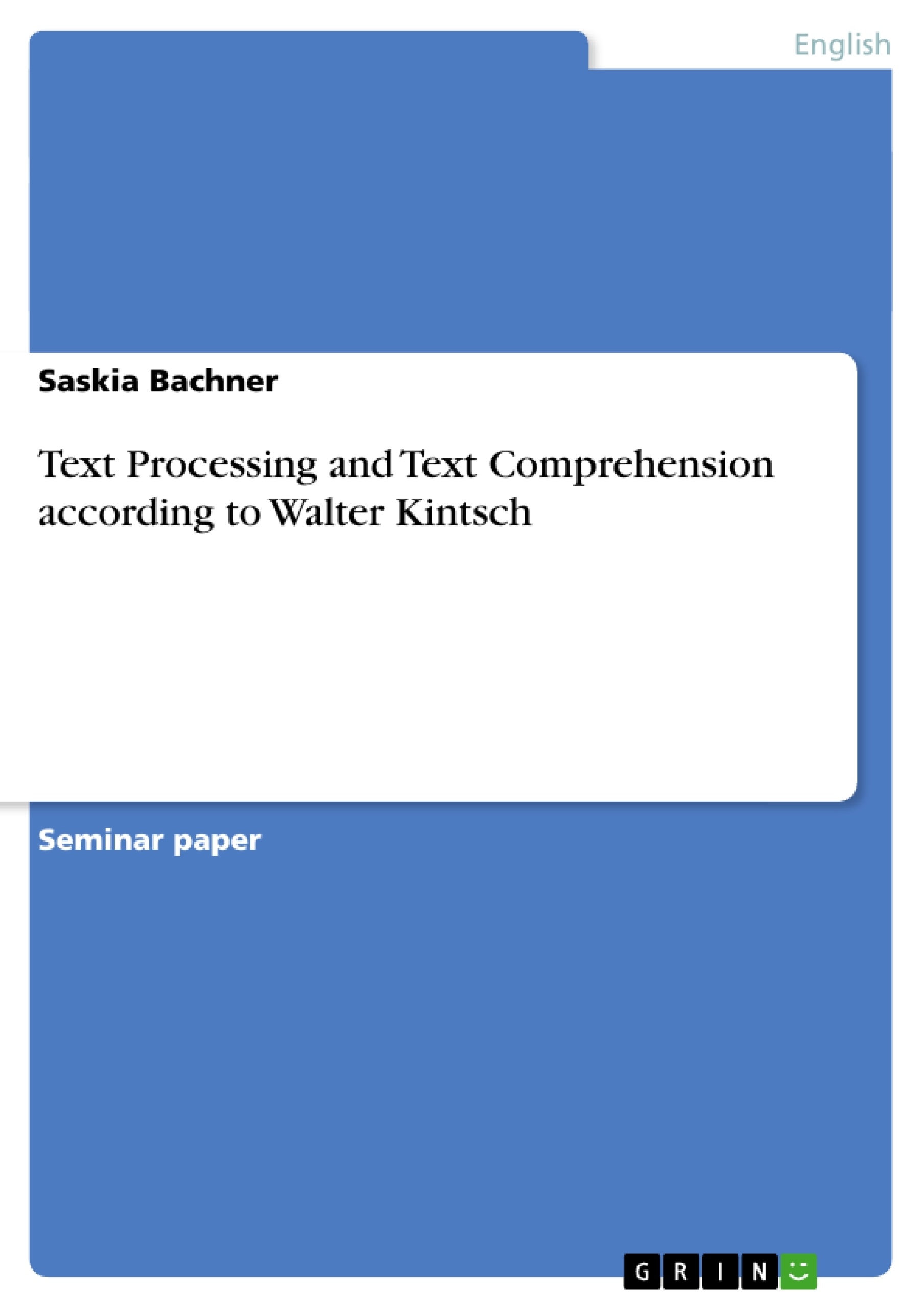Reading is a part of our daily life. It enables us to get information, for example when we read a newspaper, or it is just for entertainment. Once we have learned to read, we are not able to stop it anymore. If we see a text, we read it automatically and know what it means. But how is it possible that we understand the meaning of a text? What is going on inside our brain while we are reading? And how are we able to remember and recall something from a text?
These are central questions the text processing research concentrates on. In order to find an answer to them, researchers have different approaches. One of them is the construction-integration model by Walter Kintsch, which has its origin in several earlier models of processing.
The main field of application for this model is instruction. The results of research on learning can be used to create new instruction methods, which facilitate the process of learning and advance the ability to remember what has just been learned.
My term paper is going to concentrate on Kintsch’s construction-integration model and its assumptions. It is structured into two parts. The first part gives an overview of the theory. To be able to understand the model, I will initially describe its different components, namely: propositions, the text base, the situation model, and inferences (chapter 2). Then, I will briefly dwell on Kintsch’s earlier models (chapter 3). Afterwards, I will explain the model itself and give a short evaluation of it in chapter 4. The second part of the term paper consists of my imitation of an experiment on the existence of propositions, which was originally carried out by Gail McKoon and Roger Ratcliff (chapter 5).
Inhaltsverzeichnis (Table of Contents)
- 1. Introduction
- 2. Important Components of Kintsch's Model
- 2.1 Propositions
- 2.2 The Text Base
- 2.3 The Situation Model
- 2.4 Inferences
- 3. Earlier Models
- 4. The Construction-Integration Model
- 4.1 The Construction Process
- 4.2 The Integration Process
- 4.3 Evaluation of the Model
- 5. Experiment
- 5.1 Description of the Original Experiment
- 5.2 My Realization of the Experiment
- 5.3 Results of my Experiment
- 5.4 Comparison of the Results
- 5.5 Discussion
- 6. Conclusion
- 7. References
Zielsetzung und Themenschwerpunkte (Objectives and Key Themes)
This term paper focuses on Walter Kintsch's construction-integration model of text processing and comprehension. It aims to provide an overview of the model's theoretical framework and its practical implications for learning and instruction. The paper examines the model's key components, including propositions, the text base, the situation model, and inferences. It also explores the model's development in relation to earlier models of text processing. Finally, the paper presents an experiment replicating a study on the existence of propositions, analyzing the results and discussing their significance.
- The construction-integration model of text processing
- Key components of the model: propositions, text base, situation model, inferences
- Relationship between the construction-integration model and earlier models
- Experimental investigation of propositions
- Implications of the model for learning and instruction
Zusammenfassung der Kapitel (Chapter Summaries)
The introduction provides a general overview of the importance of text processing and comprehension in everyday life. It highlights the central questions addressed by text processing research and introduces Walter Kintsch's construction-integration model as a prominent approach to understanding text comprehension.
Chapter 2 delves into the important components of Kintsch's model. It defines propositions as the basic semantic units of text processing and explains how they are constructed from individual clauses and words. The chapter also discusses the role of the text base in organizing propositions into a coherent network and the importance of inferences in enriching the understanding of the text.
Chapter 3 briefly reviews earlier models of text processing that influenced the development of the construction-integration model. This chapter provides historical context and highlights the evolution of ideas in the field of text comprehension.
Chapter 4 presents the construction-integration model in detail. It describes the two main processes involved in text comprehension: construction and integration. The construction process involves building a propositional representation of the text, while the integration process involves connecting and elaborating on these propositions to create a coherent understanding. The chapter also evaluates the strengths and limitations of the model.
Chapter 5 describes an experiment replicating a study on the existence of propositions. It outlines the original experiment, explains the methodology used in the replication, and presents the results. The chapter compares the results of the original and replicated experiments and discusses their implications for the construction-integration model.
Schlüsselwörter (Keywords)
The keywords and focus themes of the text include text processing, text comprehension, construction-integration model, Walter Kintsch, propositions, text base, situation model, inferences, learning, instruction, experimental research, and cognitive psychology.
- Citation du texte
- Saskia Bachner (Auteur), 2007, Text Processing and Text Comprehension according to Walter Kintsch, Munich, GRIN Verlag, https://www.grin.com/document/114251
-

-

-

-
Téléchargez vos propres textes! Gagnez de l'argent et un iPhone X. -

-
Téléchargez vos propres textes! Gagnez de l'argent et un iPhone X. -

-
Téléchargez vos propres textes! Gagnez de l'argent et un iPhone X. -

-
Téléchargez vos propres textes! Gagnez de l'argent et un iPhone X. -

-
Téléchargez vos propres textes! Gagnez de l'argent et un iPhone X. -

-
Téléchargez vos propres textes! Gagnez de l'argent et un iPhone X. -

-
Téléchargez vos propres textes! Gagnez de l'argent et un iPhone X. -

-
Téléchargez vos propres textes! Gagnez de l'argent et un iPhone X.

